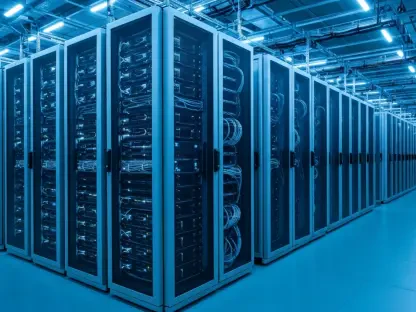The shift to Edge AI computing marks a transformative era in today’s technology landscape, where processing data closer to the source has become imperative. As computational demands grow exponentially with artificial intelligence, innovative solutions for cooling methods are paramount. Enter liquid cooling technology—changing the game for high-density data processing tasks outside traditional data centers. These systems, offering significant advantages over conventional air cooling methods, are becoming crucial to meet the demands of omnipresent Edge computing environments and ensuring optimal performance and sustainability.
Necessity of Advanced Cooling in Edge AI Environments
Growing Demands of Edge AI
As AI continues to drive data processing advancements, the demand for effective cooling strategies grows. Edge AI necessitates localized data processing, which means handling increasing volumes of information with high-speed requirements. Traditional data centers often won’t suffice for many new applications that demand real-time or near-real-time processing. Hence, locating computing power nearer to the data source has led to the concept of Edge computing. In these decentralized environments, the need for efficient cooling solutions becomes more pressing as they help prevent overheating, ensure performance consistency, and reduce the risk of system failures.
Computational requirements in these scenarios are intense, pushing conventional cooling methods like air-based systems to their limits. Edge computing setups can appear in unique and varied locations, from urban infrastructures to remote areas, each presenting distinct challenges, from atmospheric conditions to space limitations. Moreover, as cutting-edge AI applications exponentially increase data analysis requirements, making liquid cooling an attractive, if not essential, choice becomes increasingly necessary. The trend reflects a broader industry shift towards accommodating the immense heat output generated by high-performance computing devices integral to Edge applications.
Traditional Air Cooling Limitations
The inadequacies of air cooling solutions become apparent in the demanding environments of Edge computing. Air cooling, while ubiquitous, lacks efficiency when dealing with densely packed computing units requiring continuous high levels of performance. The primary drawback of air-based systems is their dependency on ambient conditions, which aren’t always controllable or sufficient in new-age computing setups beyond the confines of conventional data centers. The higher heat dissipation requirements of modern computational tasks demand a more reliable, energy-efficient solution.
Air cooling may falter in extreme environments due to its limitations in heat transfer capabilities compared to liquid cooling options. Systems relying solely on air for temperature regulation often grapple with inconsistent performance, higher energy consumption, and increased wear on hardware, ultimately impacting the usability and reliability of technology in Edge deployments. Moreover, air cooling systems’ noise levels and maintenance demands add to operational complexity, making liquid cooling solutions far more appealing for setups facing these diverse obstacles.
Embracing Liquid Cooling for Edge Success
Role and Advantages of Liquid Cooling
In high-density computing environments, liquid cooling emerges as a superior alternative, effectively addressing the shortcomings of air cooling. Utilizing liquid’s superior thermal conductivity enables effective heat dissipation, maintaining ideal operating temperatures even under peak load conditions. This method ensures a stable environment for AI workloads crucial for industrial applications, Internet of Things (IoT) devices, and mobile edge networks to function at full efficiency. The transition to liquid cooling systems is marked by reduced heat-related performance drops, prolonged hardware life, and increased system reliability.
Liquid cooling systems are advantageous for their ability to work irrespective of ambient conditions, presenting a consistent and streamlined approach to thermal management. Furthermore, their reduced dependency on energy-consuming cooling fans significantly diminishes power consumption, thus lowering operational costs and promoting sustainability. This presents a compelling case for liquid cooling technologies’ role in reducing energy footprints and achieving carbon-neutral objectives. The importance of this approach is magnified when considering economies in regions with stringent environmental regulations, fostering an alignment between technological progress and eco-friendly goals.
Diverse Applications of Liquid Cooling
The versatility of liquid cooling opens numerous pathways in applying this technology across different Edge environments. As AI and computational processing demand situational adaptability, liquid cooling solutions can accommodate various Edge scenarios—from urban settings in smart cities to industrial applications in remote locations. This adaptability includes handling dust, moisture, or extreme temperatures in inhospitable environments with less risk of system failures, adding a compelling layer of robustness to technological infrastructure.
Liquid cooling helps ensure high-performance computing remains effective and efficient under any conditions, covering multiple facets ranging from direct-to-chip cooling to immersion techniques where computing components are directly submerged in non-conductive liquids. This flexibility ensures they fit seamlessly into pre-existing and new setups striving for innovative, sustainable approaches to high-performance data processing. These technologies support the vast data analytics efforts integral to the advancements in telecommunications, transportation, healthcare, and more. Consequently, liquid cooling aligns with future-proofing strategies for industries seeking reliable and adaptable computing solutions at the Edge.
Economic and Technological Considerations
Evaluating Cost-Efficiency
Economic evaluation of liquid cooling compared to traditional methods reveals essential insights into practicality and cost-efficiency. Initial investments in liquid cooling may present cost barriers, mainly due to the specialized equipment required. However, the long-term financial benefits outweigh these initial expenditures through energy savings, revenue-related uptimes, and system longevity. These systems often offer a lower Total Cost of Ownership (TCO) due to decreased operational maintenance needs, which results in added financial predictability and reduced long-term costs, crucial for scaling operations cost-effectively.
By minimizing energy consumption and heat-induced hardware failures, liquid cooling supports longer life cycles for computational equipment, further justifying the upfront costs associated with their implementation. Additional cost advantages rest on the decreased need for expansive facility cooling infrastructure, which can otherwise represent significant ongoing expenditure in terms of energy and operational overhead. These financial considerations align the adoption of liquid cooling systems with broader business goals, providing essential competitive advantages as market demands intensify.
Innovations and Future Perspectives
The rise of innovative cooling solutions, like immersion cooling, highlights the technological strides defining modern liquid cooling systems. Immersion cooling represents a beacon of innovation, where electricity-conductive risks are mitigated, enhancing safety and operational efficacy. Fluid-immersion techniques elevate cooling capabilities by allowing seamless submersion of hardware into dielectric liquids, facilitating effective and immediate heat dispersion for uninterrupted service without noise or space limitations.
Ongoing research and development sustain the push towards developing even more efficient cooling fluids, improving specifically engineered liquid properties to further optimize performance and durability. Future perspectives show promise in maximizing thermal regulation even more, with pioneering approaches aiming to precisely tailor configurations for increasing densities of computation without sacrificing efficiency or environmental impact. These progressions signal an exciting trajectory in Edge AI computing, fostering a broadened landscape of technological possibilities that promise new, efficient, and sustainable methods well-suited for advancements on the horizon.
Strategic Integration of Liquid Cooling
Implementing Systematic Adoption
The systematic integration of liquid cooling within Edge infrastructures points to a strategic pivot necessary for sustaining future technological growth. Implementation encompasses examining current systems, identifying potential conversion or upgrades, and exploring network development opportunities. Conditions engendered by new machinery or technological scaling must be robustly addressed, ensuring that liquid cooling systems adapt seamlessly to fulfill unique and complex requirements dictated by evolving demand frameworks in varied Edge settings.
Strategically tailored approaches cater to specific application needs, ensuring ventures achieve desired performance objectives, striking a balance between power efficiency and heat management. Liquid cooling solutions actively contribute to initiatives aimed at enhancing resilience through critical infrastructure diversification. This helps alleviate traditional bottlenecks, aligning innovative computing solutions with broader efficiency objectives, energy-use policies, and global competitive standings.
Leveraging Ecosystem Collaboration
Leveraging ecosystem collaborations supports liquid cooling transitions significantly, positing partnerships and insights from successful industry applications as keystones for efficient adaptation. Collaborations between technology companies, infrastructure providers, and environmental agencies nurture shared knowledge and experiences, enriching industry standards and benchmarks for liquid cooling expertise and efficacy. Such collaborations are pivotal, collectively advancing Edge AI technological ecosystems.
Industry collaborations extend to accessing broader resource pools and shared R&D initiatives, building synergies that accelerate breakthroughs effectively. Seamless integration also requires allocating appropriate investments into research driven by collaboration networks, enhancing development through multifaceted approaches converging on practical and economically viable solutions.
The Path Forward
The evolution toward Edge AI computing heralds a transformative era in technological advancements, fundamentally altering how data is processed by relocating operations closer to the data source. This shift is becoming increasingly vital as the demands for computation skyrocket with the integration of artificial intelligence. As these demands rise, innovative cooling solutions become essential. Liquid cooling technology emerges as a groundbreaking solution, reshaping high-density data processing tasks that occur outside the conventional settings of data centers. Unlike traditional air cooling methods, liquid cooling systems provide substantial advantages, offering higher efficiency and effectiveness. They are integral to accommodating the growing demands of pervasive Edge computing environments. This technology ensures optimal performance while promoting sustainability, thereby becoming critical in maintaining the delicate balance between performance needs and environmental considerations. The future of data processing relies heavily on these innovations, as they offer enhanced energy efficiency, reduce heat output, and decrease the environmental footprint, which is crucial for shaping a sustainable technological future.









